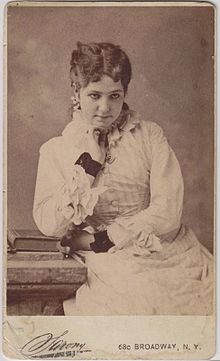| Emily Rigl | |
|---|---|
 Rigl in undated photo by Napoleon Sarony Rigl in undated photo by Napoleon Sarony | |
| Born | Netherlands or Austria |
| Occupation | Actress |
Emily Rigl (1854 - ?) was a 19th-century stage actress who primarily performed in the United States. Although not a major star, she was considered to be a talented actress.
Biography
Rigl was born in the Netherlands or Austria (sources vary on this point) and trained as a ballet dancer, as her father was an instructor in that subject.
She came with her sister Betty to the United States in 1866, where she debuted in the chorus of The Black Crook at Niblo's Garden, in which Betty had a prominent role. Emily left that long-running show after two years, studied acting, and joined Augustin Daly's company by 1874 as an actress. She was active on the stage in numerous roles on Broadway and in traveling companies at least through 1907. According to The Oxford Companion to American Theatre, although "never a major star, she was still considered one of the best actresses of her day."

Her roles included performances in Humpty Dumpty (1868), What Should She Do? (1874, for Daly), The Big Bonanza (1875), Saratoga (1875), Pique (1875, with Maurice Barrymore), The Galley Slave (1879), Mr. Barnes of New York (1888), Devil's Island (1898), Uncle Tom's Cabin (1901 production), and The Spell (1907).
She starred in a number of productions with Harry Lacy.
As a prominent actress of her day, the press would report on any "scandals" that occurred concerning Rigl. When starring with Joseph Haworth in The Crust of Society, she announced on stage that he had "made her life unbearable and I will not stand it any longer." They may have had an affair before that point, but in any event, that was the last performance of the play.
Family
Her sister Betty's acting career was much shorter, she retired from the stage after marrying Philadelphia merchant William Whitney.
References
- Broadway Photographs; University of South Carolina
- Berg, Albert Ellery. The Drama, Painting, Poetry, and Song (1884), p.320
- Bordman, Gerald & Thomas Hischak. The Oxford Companion to American Theatre, p. 529-30 (3d ed. 2004)
- Emil Rigl, josephhaworth.com, Retrieved 21 March 2013
- Emily rigle Archived 2013-12-27 at the Wayback Machine, picturehistory.com, Retrieved 21 March 2013
- (29 December 1900). Judgment Against Miss Rigl, The New York Times
- (9 May 1893). A Theatrical Review, Trenton True American
- (4 July 1920). Plays of Other Days "Booed" By London Audiences, Washington Herald
- (26 August 1894). A Conflict of Wits, San Francisco Call, p. 16, col. 4 (amusing anecdote about Rigl and matinee idol Robert C. Hilliard)
- (5 October 1907). The Spell Too Yiddish, The Billboard, p. 6 ("As the heroine's mother, Emily Rigl made a great hit with the audience, by the wonderfully realistic and comic touch she gave the role.")
- "Dark Steepy Path to Glory".
- (2 July 1898). Obituary, New York Dramatic Mirror (Whitney obituary)
- (27 June 1903). Obituary, New York Dramatic Mirror (reporting death of Betty's son Francis X. Whitney)
External links
- Emily Rigl at the Internet Broadway Database

- Emily Rigl cabinet card 1866 "The Black Crook"(archived)
- rare portrait of Emily Rigl; by Mora(archived)
- portrait of Emily Rigl; by Sarony(archive)
- Rigl on cover of The Illustrated Sporting & Dramatic News Saturday February 20, 1886